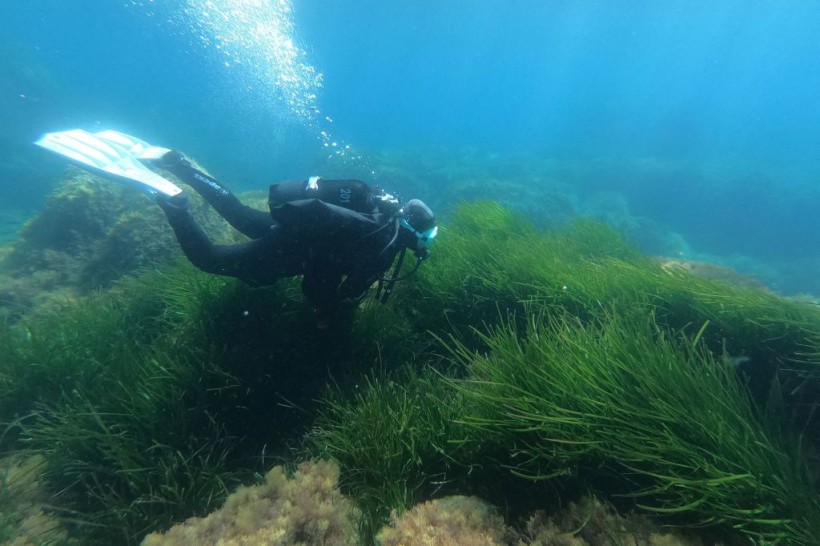Seagrass meadows are underwater grasslands that grow in shallow coastal waters around the world.
They are among the most productive and diverse ecosystems on earth, hosting a rich variety of marine life, such as fish, turtles, dugongs and seahorses.
They also provide important ecosystem services that benefit people and nature, such as filtering water, stabilizing sediments, storing carbon and supporting fisheries.
However, seagrass meadows are facing rapid decline due to human activities and environmental changes that threaten their existence and function.
A global assessment of 215 studies found that seagrass meadows have been disappearing at a rate of 110 km2 per year since 1980 and that 29% of the known areal extent has disappeared since seagrass areas were initially recorded in 1879.
The rates of decline have accelerated from 0.9% per year before 1940 to 7% per year since 1990.
Seagrass loss rates are comparable to those reported for mangroves, coral reefs and tropical rainforests and place seagrass meadows among the most threatened ecosystems on earth.
The causes of seagrass decline
 (Photo : PASCAL POCHARD-CASABIANCA/AFP via Getty Images)
(Photo : PASCAL POCHARD-CASABIANCA/AFP via Getty Images)

The main causes of seagrass decline are coastal development, degraded water quality, climate change and ecological degradation. These threats affect seagrass meadows in different ways and at different scales, as per Phys.org.
- Coastal development destroys or degrades seagrass habitats through direct physical impacts or indirect hydrological changes. Examples of coastal development activities that affect seagrass meadows include dredging, filling, land reclamation, aquaculture, tourism and shipping.
- Degraded water quality reduces light availability and increases nutrient and sediment loads, which affect seagrass growth and survival. Sources of water quality degradation include wastewater discharge, agricultural runoff, urban stormwater and industrial effluents.
- Climate change alters temperature, salinity, sea level and storm frequency and intensity, which affect seagrass distribution and resilience. Climate change impacts include thermal stress, salinity stress, sea level rise, storm damage and ocean acidification.
- Ecological degradation reduces the abundance and diversity of seagrass-associated organisms, which affect seagrass productivity and function. Ecological degradation impacts include overfishing, invasive species, disease outbreaks and herbivory.
The impacts of these threats vary across regions and species. For example, tropical seagrasses are more sensitive to temperature stress than temperate seagrasses.
Tropical seagrasses are also more affected by habitat loss due to coastal development and aquaculture activities than temperate seagrasses.
Also Read: Seagrass Could Save Us as Oceans Gradually Eats Land Masses
The solutions for seagrass conservation
The conservation of seagrass meadows requires a combination of approaches that address the root causes of their decline and enhance their recovery and resilience, as per PNAS.
Some of the possible solutions include:
- Establishing marine protected areas that include seagrass habitats and their associated species. Marine protected areas can protect seagrass meadows from direct human impacts such as fishing, anchoring and trawling. They can also enhance the biodiversity and productivity of seagrass-associated organisms such as fish, turtles and dugongs.
- Implementing integrated coastal zone management that balances the needs of human development and environmental protection. Integrated coastal zone management can reduce the pressure on seagrass meadows from coastal development activities such as land reclamation, aquaculture and tourism. It can also promote the use of best management practices such as buffer zones, sediment traps and wastewater treatment.
- Reducing nutrient and sediment inputs from land-based sources through improved wastewater treatment, agricultural practices and erosion control. Nutrient and sediment reduction can improve water quality and light availability for seagrass growth and survival. It can also prevent eutrophication and algal blooms that can smother or shade out seagrasses.
- Restoring degraded seagrass habitats through planting or transplanting seagrasses or enhancing natural recruitment. Seagrass restoration can increase the extent and density of seagrass meadows in areas where they have been lost or reduced. It can also improve the habitat quality and function for seagrass-associated organisms such as fish, turtles and dugongs.
- Enhancing the adaptive capacity of seagrass meadows to climate change through promoting genetic diversity, connectivity and refugia. Genetic diversity can increase the variation and resilience of seagrass populations to environmental stressors such as temperature, salinity and ocean acidification. Connectivity can facilitate the dispersal and migration of seagrasses across different habitats and regions. Refugia can provide safe havens for seagrasses in areas where environmental conditions are more favorable or stable.
- Increasing public awareness and participation in seagrass conservation through education, outreach and citizen science. Public awareness and participation can increase the appreciation and understanding of the value and importance of seagrass meadows for people and nature. It can also encourage the involvement and support of stakeholders such as local communities, governments, NGOs and businesses in seagrass conservation initiatives.
Seagrass meadows are vital for the health and well-being of people and nature.
By understanding the threats they face and implementing the solutions they need, we can ensure their survival and sustainability for generations to come.
Related article: World's Biggest Seagrass Discovered in Bahamas that Could Help the Environment
© 2024 NatureWorldNews.com All rights reserved. Do not reproduce without permission.



![Climate Change is Reducing Dust Levels Worldwide as Arctic Temperature Warms [Study]](https://1471793142.rsc.cdn77.org/data/thumbs/full/70320/280/157/50/40/climate-change-is-reducing-dust-levels-worldwide-as-arctic-temperature-warms-study.jpg)

